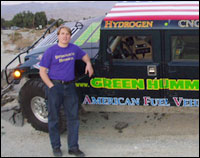
Does this look green to you?
The Hummer has come to be associated with a number of things — steroid-addled egomaniacs, over-compensating suburban dads, the highway to global-warming hell, even Monica Lewinsky’s antics in the Oval Office … But eco-friendly driving isn’t one of them.
Unless, of course, you travel in the “Green Hummer” underground, quietly developing in California thanks to the former steroid-addled egomaniac himself, Gov. Arnold Schwarzenegger (R).
The Governator claims to have traded in his Hollywood-powered ego for an eco-empowered worldview. Early in his gubernatorial campaign last year, Schwarzenegger presented a convincing motive for cleaning up California’s air: Both of his young daughters struggle with asthma.
Still, most enviros were skeptical when the proud owner of seven Hummers vowed to be a serious environmental leader and pledged to turn the state of California into the Shangri-la of hydrogen development, with 200 hydrogen fueling stations along the state’s major highways by 2010. They snickered at Ahhnold’s campaign promise to transform one of his gas-guzzling behemoths into a state-of-the-art, zero-emission, hydrogen-powered vehicle.

The Governator.
Photo: California Governor’s office.
Then last week, with much Earth Day fanfare, Schwarzenegger signed an executive order officially paving the way for his Hydrogen Highways program. “This looks kind of like a movie set here, right?” the celebrity governor joked, after climbing out of a hydrogen-powered Toyota Highlander and fueling it at a new, experimental pump at the University of California-Davis. “But it will be better because what you see here today is the future of California and the future of environmental protection. This vision for California is real and attainable.”
It wasn’t clear from Schwarzenegger’s camera-ready performance whether greening his Hummer was still part of his “real and attainable” vision, since he didn’t so much as mention it. But Michele St. Martin, spokesperson for the California EPA, says the plan is definitely underway: “The bottom line is that Gov. Schwarzenegger keeps his promises,” she told Grist in a don’t-mess-with-the-Terminator tone. “When he promised to convert his Hummer to hydrogen, he meant it, and he’s going to keep his word.”
It’s not as though the Governator is averse to pushing the envelope. The Hydrogen Highways campaign has a decidedly more ambitious time frame than the Bush administration’s “Freedom Fuel” campaign, which aims to get the first wave of hydrogen fuel-cell vehicles on the road by 2020.
It’s highly debatable, though, whether Schwarzenegger’s Green Hummer plan would actually serve the larger environmental good. Any clean-energy stickler will tell you that the idea of putting a hydrogen-powered engine into the biggest, heaviest consumer SUV on earth — as opposed to a lightweight vehicle that requires far less horsepower — is both counterintuitive and astronomically expensive.
Still, as a PR gimmick, the concept has major box-office appeal. “It gives the whole notion of clean cars an image overhaul,” said St. Martin. “It pumps up the ‘cool factor’ of the clean-car movement — and if anyone can make clean cars cool, Gov. Schwarzenegger can.” She may have a point: More than half of the vehicles sold in California today are SUVs and light trucks, and the state’s bigger-is-better drivers may view hybrids like the Toyota Prius as a tad effete.
But when Grist pressed for specifics on when Schwarzenegger’s mean, green macho machine would be unveiled, who would convert it, how it would work, how much it would cost, and how practical such technology would be for the mainstream, the governor’s spokesperson, Terri Carbaugh, was tightlipped: “The status of the Hummer conversion is that it’s moving forward — that’s as specific as I can get,” she said, “I don’t want to steal the governor’s thunder and say when [the specifics of the conversion] will be revealed. It will be sometime in the future.”
If You Build It …
For the time being, Schwarzenegger’s Hummer plan seems to be more fiction than fact, but the idea has touched off a real-world race to build the best Green Hummer — a race involving self-taught mechanics and professional car manufacturers alike. The scramble may have practical benefits for the future of hydrogen-car development.

Tai one one: Tai Robinson and a
Green Hummer.
Photo: Jon Shapiro.
The starting gun was fired last September when Schwarzenegger announced his environmental platform, which included both the Hydrogen Highways and Green Hummer plans. For the latter, consultants to the governor reviewed seven bids to do the conversion, including ones from General Motors, which manufactures the Hummer; California Motors and the Hydrogen Car Company, two new clean-energy firms; and wild card Tai Robinson, a former U.S. Ski Team racer who developed a company called Intergalactic Hydrogen with his father Fred, an autodidact mechanic who’s been jury-rigging hydrogen-powered trucks in his garage since the oil crisis of the ’70s.
What with Schwarzenegger’s special ties to GM — he actually convinced the company 11 years ago to make a civilian version of the quasi-amphibious Army vehicle after driving one on a movie set — it’s not surprising that he awarded the contract to the big automaker. But months later, the company abandoned the project on the grounds that it was “financially and technically prohibitive,” according to GM spokesperson Larry Stevens.
Not to be deterred, the littler-bidders-that-could chugged along, trying to out-innovate the Detroit giant. They have since developed half a dozen prototype Hummers boasting notable innovations.
The weight constraints presented by the Hummer forced bidders to innovate beyond fuel cells, the power source typically associated with hydrogen vehicles. Why? Because powering a Hummer solely with a fuel cell could cost almost as much as a Learjet.
“It would take a 200-kilowatt fuel cell to power a 10,000-pound vehicle like a Hummer,” explains Mike Kasaba, president of California Motors, “and seeing as it costs several hundred thousand dollars to make a 20-kW fuel cell today, we’re talking several million to create a Hummer-sized fuel cell” — a fuel cell that would be roughly as big as the Hummer itself.
So Kasaba and the other bidders pursued a different option: Hydrogen can be used in an internal combustion engine (ICE), just like gasoline. (It does release some nitrogen oxide in the combustion, but relatively little compared to a gasoline-powered ICE, and no carbon dioxide.)
“It’s a big hidden secret,” said Fred Robinson, who calls himself “the original hydrogen junkie.” “The government and oil tycoons and car manufacturers want it to remain a hidden secret, but the fact is that with a few modifications you can run any conventional combustion engine on hydrogen.”
As it turns out, most car manufacturers will confirm Robinson’s “secret”: Hydrogen can be pulled by the piston into the engine cylinder and ignited, creating an explosion like the one caused by gasoline — only hydrogen is many times more combustible. “It sounds dangerous,” says Robinson, “but with the right controls it has been proven by the Big Three [automakers] and everyone else to be a safe and reasonable drivetrain.”

Patriotic paint job included at no
extra cost.
Photo: Tai Robinson.
Intergalactic Hydrogen created “H2TOY,” the first hydrogen ICE vehicle to drive across the U.S. using hydrogen for fuel. But because hydrogen is so costly and difficult to procure, it is just one of four possible fuel sources for H2TOY.
“We designed it with the ability to use multiple fuel sources in a flexible-fuel configuration: hydrogen, CNG [compressed natural gas], ethanol, or gasoline can all be utilized either individually or in varying mixtures of any or all the above at the same time,” explained the junior Robinson. Of course, the H2TOY is hardly roadworthy from a legal standpoint, or affordable for the mainstream: Robinson estimates that the retrofit, which can be done to almost any type of SUV, adds about $200,000 to the price of the vehicle (Hummers already cost around $70,000), and it doesn’t adhere to government safety codes. (That didn’t bother Angel’s Nest Retreat, an off-the-grid New Age spa that bought a Green Hummer from Intergalactic Hydrogen as an enticement for guests.)
California Motors developed a different flexible drivetrain for its H2 Hummer Evergreen, not unlike the Prius with its hybrid gas-electric configuration: A hydrogen-powered ICE works in tandem with an electric battery. Like the H2TOY, the Evergreen is an experimental vehicle. It cannot be sold to the general public because the U.S. EPA and the California Air Resources Board have not set standards for hybrid hydrogen-electric drivetrains. But the concept is nonetheless valuable from a commercial research-and-development standpoint, and Kasaba is in negotiations with various companies who may want to use the technology for experimental purposes.
Hummerground
Though all of these prototypes are years from being certified or affordable, the concept of hydrogen-powered SUVs has proven compelling enough to draw a small cult-like fan base. Just visit GreenHummer.org, GreenHummer.com, IntergalacticHydrogen.com, H2carco.com, or calmotors.com to get a taste of the growing excitement surrounding these greener four-wheel-drive vehicles. Various green Hummers have been showcased at more than half a dozen auto shows nationwide.

A Green Hummer gets out and about.
Photo: Fred Robinson.
Green Hummer activists argue that their efforts make a bigger point: “I love efficiency — I love trying to make vehicles cleaner. That’s my passion,” said California Motors’ Kasaba. “And for some reason I just got totally excited about the idea of converting the Hummer. Why? Because it’s got such a bad rap. It’s the thing that everybody hates. And I can pop in a hybrid-engine drivetrain and give it mileage as good as a Camry.” In other words, says Kasaba, “The Hummer is the ultimate testing ground for clean-engine technology.”
But while the hydrogen-powered Hummer has conceptual appeal, “it’s enough to make any self-respecting clean-energy pragmatist wither,” said Joel Makower, green-business expert and founder of Clean Edge, a clean-technology research and consulting firm. “I mean, everyone knows that the cardinal rule of the clean-energy age is efficiency. Why waste expensive emerging technology and expensive hydrogen fuel on a 10,000-pound car when you could be using it to propel a 2,000-pound car that much more efficiently and affordably? It’s preposterous.”
And the size of the Hummer is not the only hitch. Many environmentalists don’t buy into hydrogen’s much-hyped promise as a fossil-fuel alternative — especially considering that, at least in the short term, most research on hydrogen fuel production is focused on harvesting the gas from hydrocarbons (i.e. fossil fuels), which is a cheaper and more petroleum-lobby-friendly approach than, say, finding ways to use solar and wind power to extract hydrogen from water.
Schwarzenegger’s director of clean air policy, Allan Lloyd, recognizes these concerns, but emphasizes that the current hydrogen-extraction methods and even the Green Hummer itself are transition technologies — part of a process of helping consumers and industries adjust to a revolutionary idea. “The Green Hummer makes a point that no other car can make: If we can get this technology to work on a Hummer, we can surely get it to work on any car,” he told Grist. “Better yet, it helps demonstrate that Detroit and Washington don’t have to wait the many decades to get hydrogen development underway. It’s technically feasible now.”
Further down the road, perhaps, we’ll be driving efficient vehicles powered by hydrogen derived from the elements — sun, wind, and water — and the word “hummer” will fade into history, associated more with the Clinton era than the 21st century.

